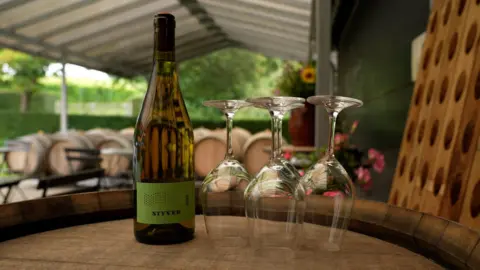 BBC
BBCSipping a glass of local wine is likely not what springs to mind when visiting Scandinavia, but this colder, northerly region is emerging as a new wine frontier.
Hundreds of commercial vineyards are now dotted across Denmark, Sweden, and even Norway, as a first generation of professional winemakers transform what was once a niche hobby into a small but flourishing industry.
Far north of France’s Bordeaux or California’s Napa Valley, more than 10,000 vines grow on a hillside on Zealand, Denmark’s biggest island.
“People have found out that it is actually possible to grow wine in Denmark, so newcomers are coming, year after year,” says Nina Fink, as she shows the BBC her three-hectare (seven-acre) winery, Vejrhøj Vingård.
Nina and her husband Niels started their operation 13 years ago, after retiring from business jobs in Copenhagen. They grow predominantly green grapes, producing floral white wines, as well as sparkling and rosé.
“We have longer summer days with more sunlight than you have in France or in Italy, so the conditions are different,” she explains.
For most Scandinavian vineyards, solaris is the grape of choice – an aromatic, hybrid variety that’s well-adapted to colder climes, ripens easily, and is more disease resistant, allowing vineyards to avoid spraying pesticides.
The grape was first bred in Germany in 1975, but only adopted in Scandinavia from 2004, after which winemaking took off.
Niels Fink says that people are positively surprised when they taste the wines from Vejrhøj Vingård. “There’s a little twinkle in their eye, then comes this half smile,” he chuckles. “People like it.”
The Finks sell their bottles direct from the winery, but they also supply some of Copenhagen’s top restaurants, including the three Michelin star Geranium.
Initially they made just 4,000 bottles annually, but now they sell 20,000. “We are limited by the supply we are able to offer,” says Mr Fink.

Commercial vineyards in Denmark and Sweden have only been allowed under European Union rules since 2000. Winemaking picked up around 2010, seeing a shift from amateur growers to more ambitious production.
Curiosity, and the fact “it’s possible”, has attracted wine entrepreneurs, explains Jean Becker, from the Danish Wine Association.
“I was one of the ones that started in the year 2000. We were six growers,” says Mr Becker, standing in his vineyard 25km (15 miles) north of Copenhagen.
There are now 150 commercial wineries in Denmark with a combined 125 hectares of vines, plus more than 1,000 hobby growers.
Meanwhile, Sweden has 47 commercial operators spanning 193 hectares, according to the Swedish Wine Association, and the biggest has 125,000 vines.
“I began with 500 vines,” said Jean Becker, “Today, new winegrowers are starting with 15,000-25,000. They start bigger in scale. Is there a market for it? The answer is yes.”
But it’s an industry still in its infancy, compared to the 800,000 hectares cultivated in France, and almost a million hectares in Spain.
In southern Zealand, Jesper Rye Jensen, who runs Vesterhave Vingaard, produces red wines from varieties like pinot noir and merlot, usually associated with France.
“It is very challenging because it’s new for us,” he says. “We have to learn it. It’s not like southern Europe, where they had generation after generation.”
Data shows that both Denmark and Sweden have seen average temperatures rise almost two degrees celsius over the past 40-50 years, resulting in milder winters and a longer fruit-growing season. But there remains a risk of frost damage.
Jesper Rye Jensen says that as a northerly wine producer climate change works in his favour. “We wine growers in Denmark are happy that we are getting a little bit better weather.”
But Niels Fink reckons that the warming climate is a double-edged sword. “Climate change is accompanied by all kinds of evils, such as more extreme weather phenomena, long drought, heavy rain. That is as threatening here as it is elsewhere.”
 Thora Winery
Thora WineryHowever, Prof Torben Bo Toldam-Andersen, a fruit science researcher from the University of Copenhagen, says that rather than a longer growing season, it is the emergence of new, hardier grapes that largely kick-started the rise of Scandinavian wineries. “Climate change makes it easier for sure, but the main driver is the new cultivars.”
He is leading a programme called “FastGrapes”, which tests varieties of vines, to find the most robust and best suited to northern Europe.
They are selected according to how quickly their grapes ripen, and their resilience to pests, disease, and other environmental stresses. New seedlings can then be grown on a higher scale.
“There are so many things that go into the perfect wine,” says the researcher. “Part of that search happens in the lab… you can see the genes that make it strong.”
The first chosen vines are now growing in 15 test locations, across Scandinavia, Lithuania, northern Germany and Belgium.
But even with the best possible grape varieties and warmer weather, Scandinavian wineries face numerous challenges, such as high labour costs and strict rules on the use of chemical treatments to tackle any disease in the vineyards.
Romain Chichery says it can also be difficult for wineries to find workers. Born and raised in France, he moved to Sweden shortly after completing his studies in winemaking and viticulture.
Now 27, the winemaker works at Thora Vineyard on the country’s southwestern Bjäre peninsula. “We need to train workers, or we have to bring them from outside [the country],” he says.
But ”starting from scratch” in Sweden, he adds that he enjoys the freedom to experiment. “It’s not just copy paste, which has been done for decades, or centuries, in the older viticulture world.”
Thora’s owner, American expat Heather Öberg says all the effort and expense is worth it. “We can compete with other European wines,” she says.
Yet, home-grown Scandinavian wine currently makes up just a fraction of the consumer market, and bottles are expensive. Danish wine in Denmark costs from 200 kroner ($27; £22) a bottle upwards, more than twice the price of the cheapest French and Spain imports. Only a negligible amount is exported.
“We will never get in competition with France, Italy and Spain because they have very low prices,” says Mr Becker.
At his central Copenhagen wine shop, Vino Fino, owner Nicolai Christiansen mostly sells French wine. Yet he says he has recently sold a case of Danish wine to a bar owner in France.
“If you can sell it to a French guy, you can probably sell it to everybody,” he jokes.
However, he is still to be convinced about Danish wine. “The Danish wine is still too expensive,” he says. “It’s coming up. but I still think there’s some way to go before the quality is there.”





